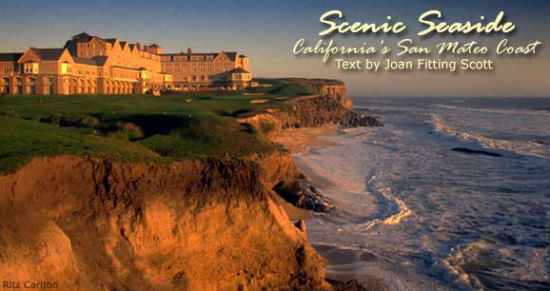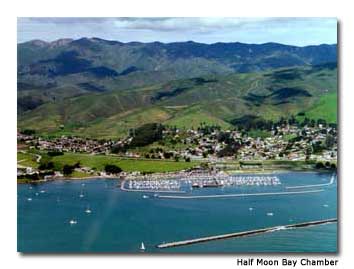
When you leave Santa Cruz, California, driving north to San Francisco along the Pacific Coast, one of the last signs you see says, “Next Gas 33 Miles.” (53 km). This extraordinary stretch of road — a place of grazing cattle, aromatic eucalyptus and salty sea air — runs through one of the last remaining undeveloped coasts next to a major metropolitan area in the world.
Peninsula Open Space Trust (POST), a nonprofit agency dedicated to preserving the beauty, character and diversity of the San Francisco Peninsula, has played a significant role in helping keep these coastal lands wild. Since its founding, the organization has protected nearly 55,000 acres (22,260 hectares) of open space in San Mateo and Santa Clara valleys. That’s equivalent to an area one and a half times the size of San Francisco.
While the pristine beauty of the ocean and the flower-dotted hillsides are mesmerizing, there’s a whole lot to see and do along Highway 1, also known as the Cabrillo Highway. Popular activities include berry picking, elephant seal watching, lighthouse gazing, hostelling and hot-tubbing.
Twenty-seven miles (43 km) north of Santa Cruz, the 115-foot-tall (35 m) Pigeon Point Lighthouse — one of the tallest lighthouses in America — has been a beacon to mariners since 1872. Its Fresnel lens (no longer in use) weighs in at 8,000 pounds (3,629 kg) and stands 16 feet tall (4.8 m). The white brick lighthouse has been closed to the public since a section of its cornice fell off in 2001. The edifice can be seen from the grounds, however.
For an off-beat experience, stay at the Pigeon Point Lighthouse Hostel, with its open-air, under-the-stars hot tub perched on the cliff overlooking the ocean. Or explore 1,000 year-old redwood trees at nearby Butano State Park.
The coastal areas around the lighthouse are loaded with wildlife. At least 150 species of birds nest here, and visitors to this area can watch for gray whales making their annual coastal migration. A few miles south of the lighthouse, the Año Nuevo State Reserve features the largest breeding colony in California for northern elephant seals, which spend most of their lives far out at sea.
Northeast of the lighthouse, the town of Pescadero might as well be a New England burg. Frame houses and a winsome white church complete with spire recall Yankee beginnings, although the town was founded by Portuguese and Italian immigrants. One of the town’s highlights is the springtime Pescadero Chamarita Festival, a Portuguese festival replete with marching bands and equestrian groups. Summertime is berry-picking time, and CoastWays Ranch in Pescadero — a family business since 1917 — offers U-Pick Olallie blackberries. (It’s best to call ahead for hours and picking dates.)
Pescadero enjoyed its heyday at a time when visitors came by stagecoach to enjoy resort hotels long since gone. Stage Road, a dramatic hairpin inland route, connects Pescadero with San Gregorio to the north.
San Gregorio sits inland a mile (1.6 km) from the ocean. The San Gregorio General Store has been serving the area’s farming community since 1889. It’s kind of like New York City here: You can get anything your heart desires. That would include seed, coal hods, cast-iron cookware, crockery, beeswax and western and work clothing. You’ll also find books of every kind, wine (the website says it ranges from “fine to rot gut”), advice and lots of banter. (The store calls it something less refined.)
There’s live music on weekends at the store/saloon, and all manner of humankind stops by. Bicyclers in Day-Glo shorts and reptilian helmets, bikers with their Harley-Davidsons, cowboys, hippies, tourists and doddering old gents in tam-o’-shanters. Everybody, from the wholesome to the grizzled, shows up here. If you have a hat fetish, pull up a chair, buy a glass of wine and watch the duel of the headgear.

If you head up the coast in the fall, the contrast between the deep blue of the ocean and adjacent fields of pumpkins is stunning. Half Moon Bay, 30 miles (19 km) south of San Francisco, is famous for its pumpkins. Each year, the Half Moon Bay Art & Pumpkin Festival, in October, features a pumpkin parade, a haunted house, pie eating and carving, arts and crafts, and live music.
You might want to stop by Farmer John’s Pumpkin Farm in Half Moon Bay to pick out one of the orange orbs for your next Jack-o’-lantern. Farmer John Muller — yes, he’s a real person — and his wife, Ida, grow seasonal vegetables. “But pumpkins are our passion,” he says. The pumpkin farm has 25 varieties of pumpkins and gourds from which to choose — just one of many choices you’ll need to make along this remarkable, scenic stretch of highway.
If You Go
Half Moon Bay Coastside Chamber of Commerce & Visitors’ Bureau
San Mateo County Convention and Visitors Bureau
www.visitsanmateocounty.com
